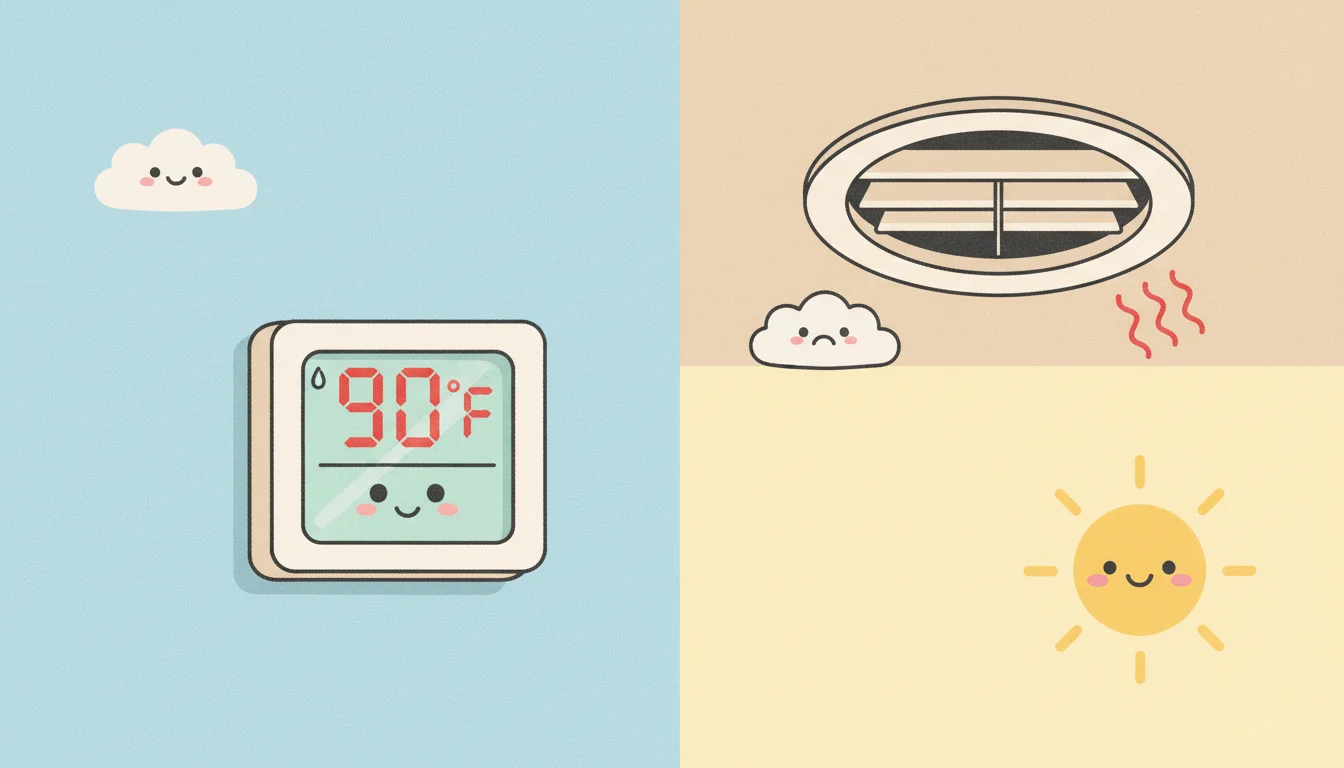One Room 10 Degrees Hotter? Uncover the Hidden Flaw in Your Home
It’s a frustratingly common problem. The rest of your house feels perfectly comfortable, but one room feels like a sauna, consistently running 10 degrees hotter than everywhere else. You’ve likely tried closing vents in other rooms or blasting the AC, only to find the problem persists.
This dramatic temperature difference isn’t just an annoyance; it’s a major sign that your home’s heating and cooling system isn’t working as it should. Understanding the root cause is the first step toward a permanent solution.
You'll Learn About
Why Is One Room So Much Hotter Than the Rest of the House?
Solving the mystery of the rogue hot room begins with identifying the culprit. The issue rarely stems from a single, simple problem. More often, it’s a combination of factors related to airflow, your home’s construction, and the HVAC system itself.
Airflow and Ductwork Problems: The #1 Culprit
Your HVAC system relies on a network of ducts to deliver conditioned air. When this network is compromised, some rooms get left behind. Poor airflow is the most frequent cause of a single hot room.
Ducts that are crushed, kinked, or have become disconnected in your attic or crawlspace can’t deliver enough cool air. Even small leaks in the ductwork can significantly reduce the volume of air reaching its destination, forcing your system to work harder for less effect.
Another common issue is a blocked or closed damper. Dampers are small plates inside your ducts that regulate airflow to different parts of your home. If a damper for the hot room’s supply duct is mostly closed, the room will be starved of cool air.
The Room’s Location and Sun Exposure
Sometimes, the problem isn’t the HVAC system but the room itself. Rooms with large, south-facing windows absorb a tremendous amount of solar heat throughout the day. This is especially true for homes with older, single-pane windows.
A room situated directly above a hot garage or below an under-insulated attic will also struggle to stay cool. Heat naturally radiates through ceilings and floors, constantly fighting against the cool air your AC is trying to provide.
An Imbalanced HVAC System
Your heating and cooling system may be the source of the imbalance. If the thermostat is located in a naturally cool part of the house, like a shady hallway, it will shut the AC off before the hotter rooms have had a chance to cool down.
Furthermore, the entire system could be improperly sized. An air conditioner that is too small for your home will struggle on hot days, often failing to adequately cool rooms that are farthest from the unit.
Your Action Plan: How to Finally Cool Down That Hot Room
Fixing a hot room doesn’t always require a massive investment. Start with simple, low-cost solutions and work your way up to more involved fixes if the problem persists. This systematic approach will help you pinpoint the issue without unnecessary spending.
Simple DIY Fixes You Can Try This Weekend
Before calling a professional, perform a thorough inspection and try these easy adjustments. You might be surprised by what a difference these small changes can make.
First, walk through your entire house and ensure every supply vent and return air grille is open and completely unobstructed by furniture, rugs, or curtains. A blocked return air vent can disrupt the airflow for the entire system.
Next, check your furnace filter. A clogged filter severely restricts airflow, reducing your HVAC system’s efficiency and its ability to cool your home evenly. Replace it if it’s visibly dirty.
For rooms with intense sun exposure, install blackout curtains or reflective window film. This is one of the most effective ways to block solar heat gain and reduce the cooling load on your AC unit.

Intermediate Solutions for a Lasting Fix
If the simple fixes don’t solve the problem, it’s time to investigate your ductwork and insulation. These steps require a bit more effort but address the most common underlying causes of a hot room.
Visually inspect the accessible ductwork in your attic, crawlspace, or basement. Look for any obvious tears, gaps, or disconnected sections. You can seal small leaks and joints with mastic sealant or aluminum foil tape for an immediate improvement in airflow.
Proper attic insulation is also critical. Check the depth of your insulation; if it’s below modern standards, heat from the attic could be radiating into the room below. Adding more insulation is a cost-effective way to improve comfort throughout your home, much like understanding the total basement HVAC cost can prevent overspending on larger projects.
Advanced Solutions: When to Call a Professional
Sometimes, the problem lies deep within your HVAC system and requires an expert. If you’ve exhausted the DIY options, a professional can diagnose and resolve complex issues.
An HVAC technician can perform a pressure test to find hidden leaks in your ductwork. They can also use a camera to inspect the inside of your ducts for blockages or damage you can’t see from the outside.
For a permanent solution, you might consider installing a zoned HVAC system. Zoning allows you to control the temperature of individual rooms or areas independently by using multiple thermostats and automated dampers. This is an ideal, albeit more expensive, solution for homes with persistent temperature imbalances.
Another powerful option is a ductless mini-split system. These units provide dedicated heating and cooling for a single space, making them perfect for a problem room that never seems to get comfortable. They are incredibly efficient and don’t rely on your existing ductwork.
The Overlooked Culprit: Air Pressure Imbalance
One of the most significant yet least-discussed causes of a hot room is air pressure. When your HVAC system pushes cool air into a room through a supply vent, that same amount of air needs a way to get out and return to the furnace or air handler.
If a bedroom door is closed, and there isn’t an adequate path for air to escape, the room becomes pressurized. This positive pressure actively pushes the cool, conditioned air out through any available crack around windows, outlets, and the door itself. At the same time, it prevents new, cool air from entering, creating a hot, stuffy environment.
The solution is ensuring a proper return air path. The easiest method is to leave the door open. If privacy is needed, ensure there’s at least a one-inch gap under the door. For a more robust solution, a professional can install a transfer grille in the wall or a jumper duct in the attic to allow air to circulate freely even when the door is closed. This same principle of controlling airflow is crucial when you need to stop smoke from going upstairs during a home incident.
Comparing Solutions: A Quick-Reference Guide
Choosing the right approach depends on your budget, effort, and the severity of the problem. This table breaks down the most common solutions to help you decide where to start.
| Solution | Estimated Cost | Effort Level | Potential Impact |
|---|---|---|---|
| Check/Open Vents | $0 | Low | Low to Medium |
| Replace Air Filter | $15 – $50 | Low | Low to Medium |
| Install Blackout Curtains | $50 – $200 | Low | Medium |
| Seal Accessible Ducts | $20 – $60 (DIY) | Medium | Medium to High |
| Add Attic Insulation | $500 – $1500+ | High (or Professional) | High |
| Install a Ductless Mini-Split | $3,000 – $7,000+ | Professional | Very High |
| Install HVAC Zoning | $2,500 – $10,000+ | Professional | Very High |
Preventing Future Hot Spots in Your Home
Once you’ve balanced the temperature in your home, a few long-term strategies can help you maintain comfort. Consistent maintenance and smart upgrades can prevent future hot spots from developing.
Schedule annual professional maintenance for your HVAC system. A technician will clean the coils, check refrigerant levels, and ensure all components are working correctly, maximizing efficiency and airflow.
Consider upgrading to a smart thermostat with remote sensors. Placing sensors in multiple rooms, including the problem one, gives the thermostat a more accurate reading of your home’s overall temperature, leading to more even and efficient cooling cycles. It’s a modern design opportunity, much like realizing an off-center vanity light can be a unique feature, not a mistake.
Finally, don’t underestimate the power of landscaping. Planting deciduous trees on the south and west sides of your home can provide significant shade during the hot summer months, naturally reducing the amount of heat your house absorbs.
A single room that’s 10 degrees hotter than the rest of the house is a clear signal of an underlying issue. By systematically checking for problems with airflow, insulation, and your HVAC system, you can reclaim that uncomfortable space. Start with the simplest fixes and don’t hesitate to consult a professional for a comprehensive solution that will restore balance and comfort to your entire home.

